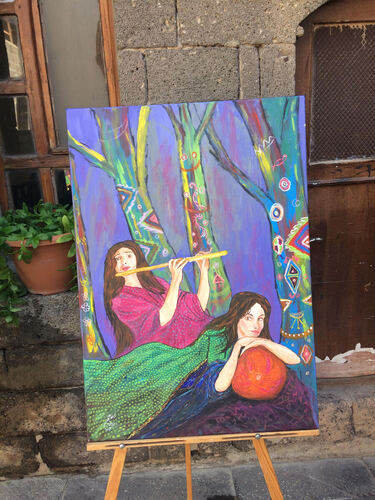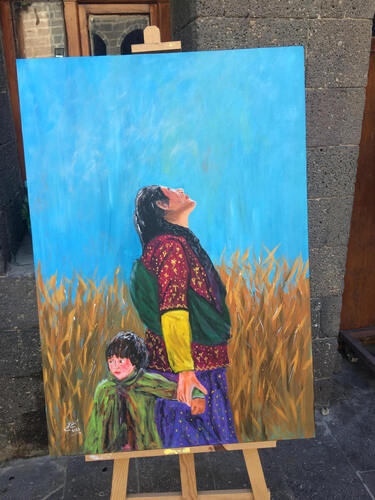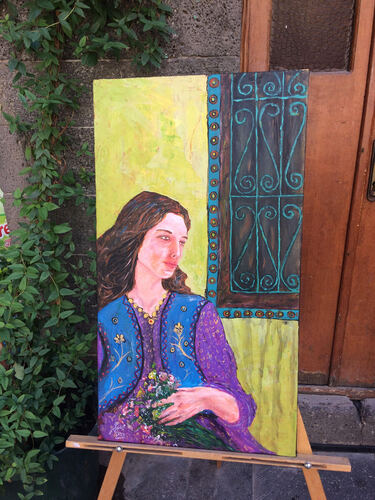Walat RaminAzad
Not concerts, panels, discussions, symposia, theater, and cinema. In Amed, more than anything else, visiting art exhibitions makes me happy. There are many institutions and organizations in Amed that hold exhibitions of modern and contemporary art. According to the activities, the main ones are Ridvan Kuday Gallery, A4 Sanat atelier, Merkezkah Collective Center, Zervazan Palace, and Amed Metropolitan Municipality.
In Amed, I really wanted to go to an exhibition of an artist or artists from other parts of the country. But I have never seen any exhibitions of Eastern, Southern, or Western artists in this city. I saw a news item; an artist from Erbil has opened a painting exhibition in Amed. How can an art institution be established that opens exhibitions of artists from other parts of the country in Amed?

The eighth exhibition of Abdulmuttalib Gardi was held at the Tigris Culture and Arts Association from October 4 to 8.
Abdulmuttalib Gardi highlights women's suffering in his paintings. In each painting, he shows a face, another side of women's suffering. There is another aspect in his paintings that shows itself more in Focus, the celebration of color. More than a celebration of colors, I would like to define it as the "Dance of Colors".
In dance and celebration, there is a big difference. The difference between celebration and dance is this: there is celebration in dance, but there is no dance in celebration. Celebration is a key feature of dance. In dance, everyone is present with their differences. No one has to follow the same ideology, believe in the same religion, or love the same things, but there is a contrast between these differences. This is created by celebration. Because of that, simply defining or naming the celebration of colors is lacking in many ways.
There are many contradictions in dance. In dance, there is movement, energy, rhythm, joy, happiness, enthusiasm, and removing emotions such as pain, sorrow, grief, fear, anxiety, and worry. Therefore, dance is a catharsis. Abdulmuttalib Gardi's paintings contain all of these.

Colors are dancing in his paintings; the dance of contrast colors. It gave me a feeling of happiness. The dance of colors intoxicated me, creating a washing and cleansing in my mind and soul.
There was also a contradiction in his paintings. In the dance of colors, the women were in pain, worried, and sad. Abdulmuttalib may explain this contradiction as follows: Even if a woman suffers, her life is still full of colors.
Is there a state of happiness for women in the dance of colors? What would the paintings look like if they painted happy, enthusiastic, cheerful, beautiful women? Will the artistic level of the paintings be bright and high or low and slow? Why do we always mix women and pain? Are we afraid of happy women? This symbol of women in art needs to change.
For me, there is a criterion for bright and good paintings: one must not be satisfied with looking at paintings, one must look at them for hours. Even look at it from the heart, from the soul, and the eyes. Sometimes I go to an exhibition, I finish it in fifteen minutes and I'm satisfied, but sometimes the paintings don't let me leave the exhibition, they look at me. This was the case with Abdulmuttalib Gardi's exhibition. There were some paintings I couldn’t get enough of, and I miss them now.

For me painting is color. The painter is also an expert, a scholar, and a master of colors. The painter is the artist of colors, he knows their spirit, their psychology, and their celebration. The painter can combine the colors that are most contradictory together and make them dance. Not only for painters but also for designers, decorators, architects, and photographers... Creating a celebration of colors in painting is difficult, it requires skill, but creating a dance of colors is even more difficult. It takes expertise and an artistic spirit. Abdulmuttalib Gardi has reached that level in painting.
Before we moved to the cities, in the villages and our nomadic life, our culture of clothing, carpets, and rugs was very colorful. There was a dance of colors in our visual culture. For example, today in Jazir, in Julemerg, those colorful dances are no longer there. In 2016, I saw the dance of colors with my own eyes in Hawraman, but in the cities, our clothes are mostly black and meaningless.
Now I miss the rest of Abdulmuttalib Gardi's paintings and ask: Will art give us back what we have lost in the cities?









